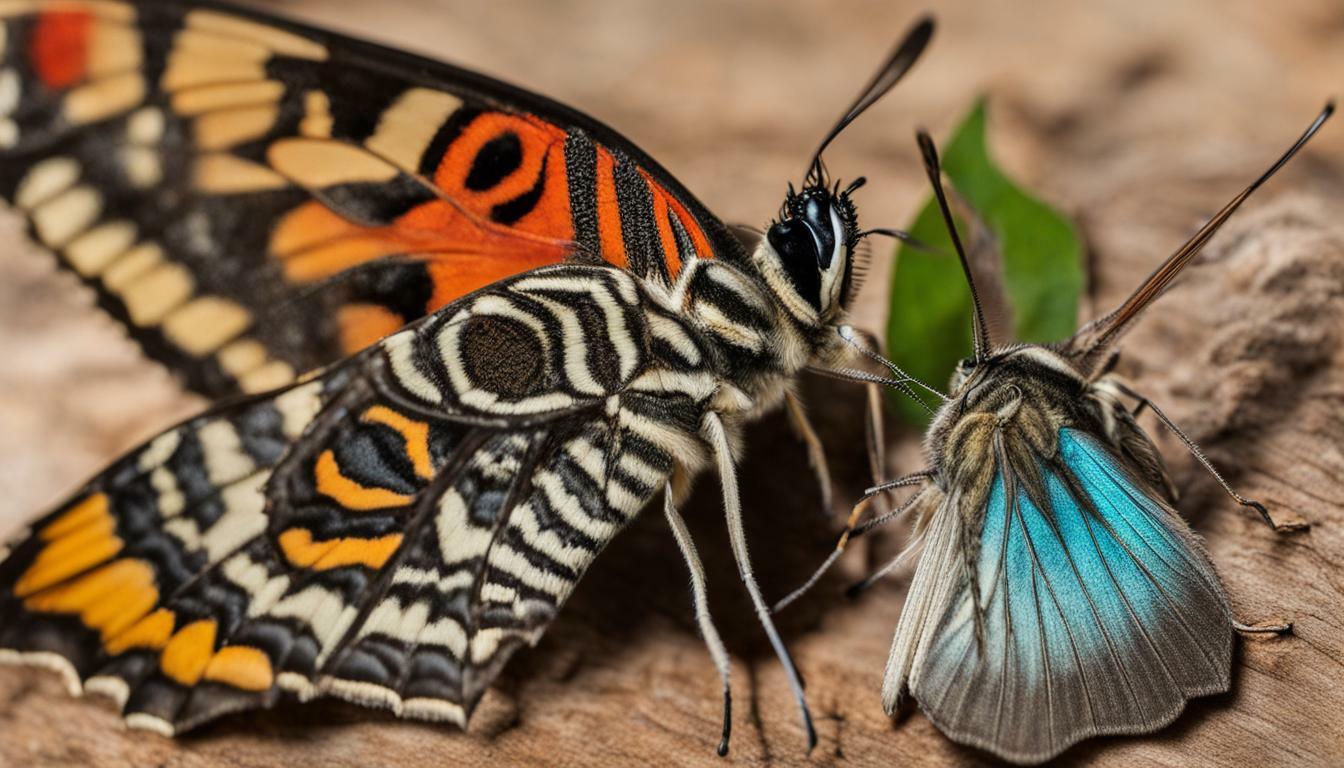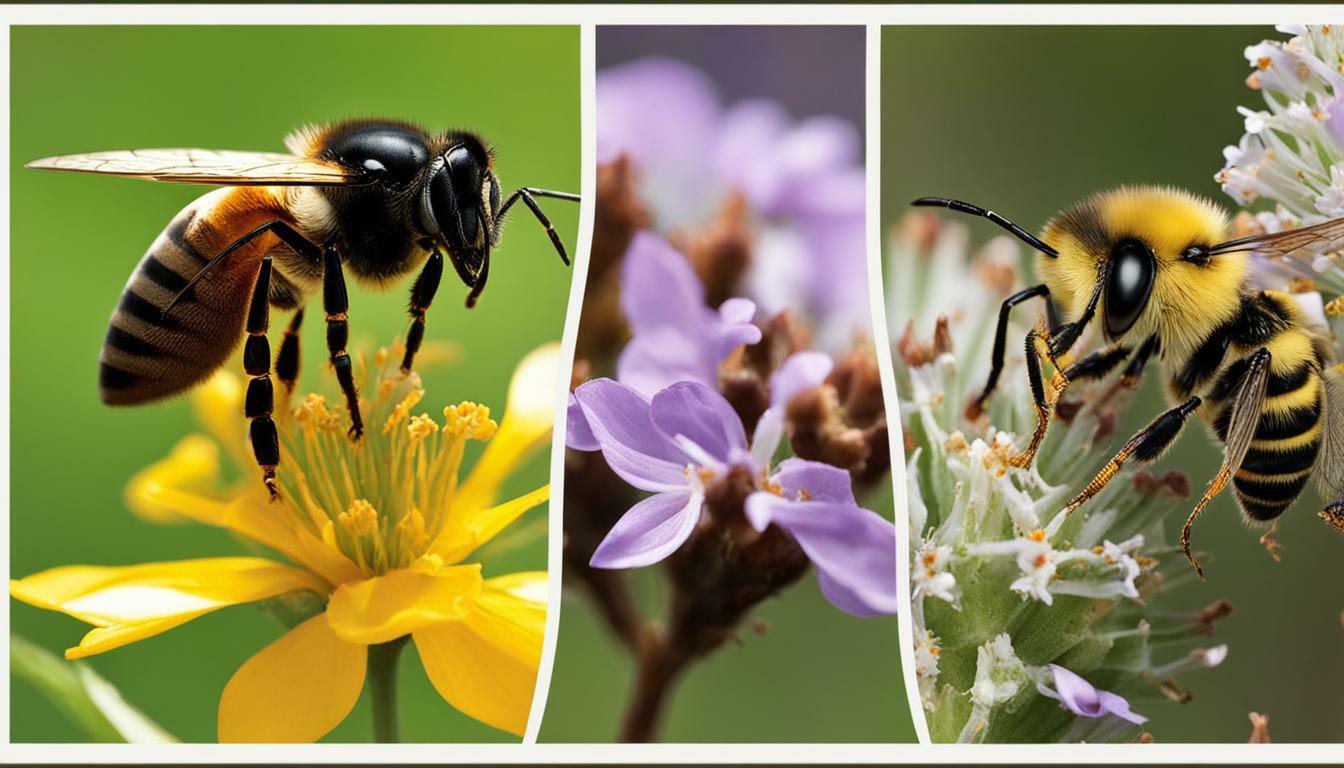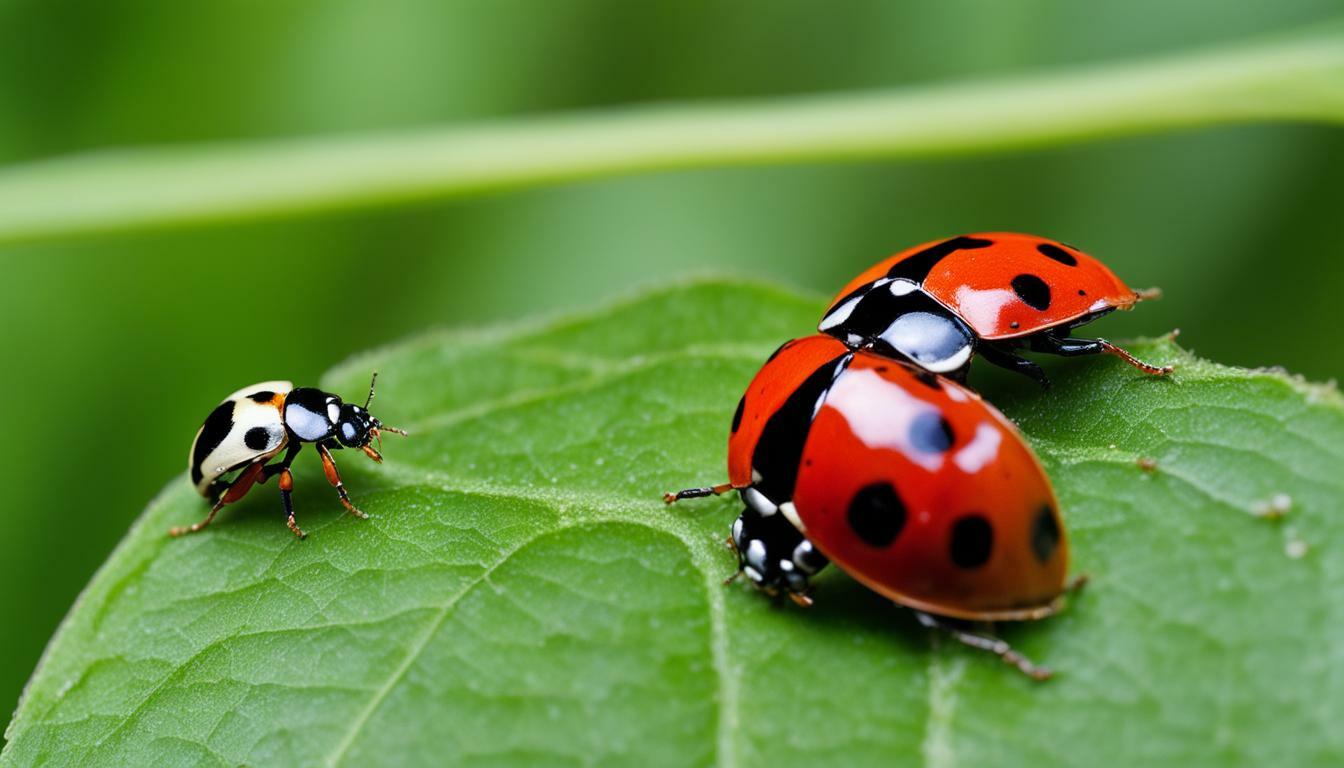Have you ever been sitting outside on a warm summer evening and noticed a fluttering insect nearby? Was it a moth or a butterfly? At first glance, they may look similar, but there are key differences between the two. In this guide, we will explore the physical characteristics, habitats, behaviors, and adaptations of moths and butterflies to help you distinguish between the two.
Key Takeaways
- The differences between moths and butterflies go beyond just their appearance.
- Understanding the physical attributes and behaviors of these winged creatures can help you identify whether you are looking at a moth or a butterfly.
- Moths and butterflies have unique adaptations to survive and thrive in their respective habitats.
Physical Characteristics of Moths and Butterflies
When it comes to physical characteristics, moths and butterflies have some similarities, but many unique differences that can help distinguish one from the other.
One key distinguishing feature of moths is their often fuzzy or furry bodies, while butterflies typically have smoother bodies. Moths are also generally darker in color and have more muted wing patterns compared to the bright and colorful wings of many butterflies.
Another major difference is the shape and size of their antennae. Moths have feathery and often larger antennae, while butterflies have slender antennae with a small knob at the end.
Additionally, moths and butterflies have different body structures. Moths typically have a stockier build with thicker bodies and shorter wings, while butterflies are more slender with longer wings that are held vertically when at rest.
Overall, carefully observing these physical characteristics can help identify whether you are looking at a moth or butterfly.
Moths and Butterflies in Different Habitats
Moths and butterflies are part of the same insect order, Lepidoptera, characterized by their distinctive wings covered with scales. However, they are classified into two different families based on their physical and behavioral differences. While butterflies are active during the day and are often brightly colored, moths are primarily nocturnal and have duller, earthy tones that blend into their surroundings.
In addition to their differing activity patterns, moths and butterflies also exhibit variations in their habitats and food preferences. Butterflies tend to prefer open, sunny habitats such as fields and gardens, while moths thrive in more diverse environments, including forests, grasslands, and wetlands. Many moth species are also specialized feeders, consuming only specific plant types, while butterflies tend to have a more varied diet.
Another way in which moths and butterflies differ is through their behaviors during different life stages. For example, moth larvae (caterpillars) often spin silk cocoons in which they pupate, while butterfly larvae form chrysalises that protect them during their metamorphosis. Moths may also exhibit different behaviors in their adult stages, such as the ability to fly for much longer periods than butterflies due to their more efficient wing structure.
Moth and Butterfly Classification
There are over 180,000 known species of Lepidoptera, classified into 39 families. Within these families, moths and butterflies are further classified based on physical characteristics such as wing shape, antennae structure, and body size. For example, the Papilionoidea superfamily, which includes most butterfly species, is distinguished by their clubbed antennae and slender bodies. Meanwhile, the Noctuoidea superfamily, which contains the majority of moth species, typically has feathered or simple antennae and stockier bodies.
These physical differences are also reflected in the varied behaviors and habitats of moths and butterflies. Understanding the distinct characteristics of each group can help us better appreciate their diverse roles in the ecosystem.
Life Cycle and Behavior of Moths and Butterflies
While moths and butterflies may have some similarities in their life cycles and behaviors, they also have distinctive differences that can help us identify whether we are looking at a moth or butterfly.
For instance, both moths and butterflies go through four stages of development: egg, larva (caterpillar), pupa (chrysalis), and adult. However, the time it takes for each species to complete these stages can vary greatly.
In terms of behavior, both moths and butterflies engage in mating rituals during their adult stage. They also have specific times of activity, with some being diurnal, active during the day, while others are nocturnal, active at night. However, moths are typically more active at night, while butterflies tend to be active during the day.
Another similarity between moths and butterflies is their ability to migrate. Some species of both insects travel long distances to mate or find food. The monarch butterfly is perhaps the most well-known migratory species, while some moth species also undertake long-distance journeys. However, the environmental cues that trigger their migration can be different.
Moth and Butterfly Identification
To identify whether we are looking at a moth or a butterfly, we can examine their physical characteristics and behavior. Both have distinctive wing patterns and colors, but moths tend to have less visibly appealing wings, featuring hues of brown, gray, and black, while the wings of butterflies often boast bright and vivid colors. Moths also typically have feathery antennae, while butterfly antennae are usually thin and straight.
Another key difference between moths and butterflies is their feeding behavior. While butterflies feed on nectar from flowers, moths have a more varied diet, including nectar, sap, and even animal material.
Overall, understanding the similarities and differences between moths and butterflies can help us appreciate the unique qualities of both insects. While they both belong to the order Lepidoptera, they have evolved to thrive in different environments and possess distinct characteristics that set them apart from one another.
Adaptations and Survival Mechanisms
While moths and butterflies share many similarities, they have evolved unique adaptations to survive and thrive in their respective habitats. Understanding these adaptations can help distinguish moths from butterflies.
One of the most notable differences between moths and butterflies is their coloration. Butterflies often have brighter, more vibrant colors, while moths tend to be duller and more subdued. This is because butterflies rely on their bright colors to attract mates and warn predators of their toxicity, while moths use camouflage to blend into their surroundings.
Moths that blend in with their environments have evolved to resemble the flowers or bark of the trees they rest on, making them more difficult to spot by predators. Some moths even have markings that resemble the eyes of larger animals, scaring off potential predators.
Butterflies, on the other hand, have developed a range of defensive mechanisms. Some species have evolved to mimic other, toxic species of butterflies, making them less likely to be eaten by predators. Others have elongated wings that allow them to fly faster and more erratically, making them harder to catch.
Moths have also developed unique adaptations to help them navigate the dark. Many species have highly sensitive antennae that can pick up even the slightest scent of potential mates or food sources in the night. Some moths also use echolocation to navigate and locate objects in their environment.
Overall, moths and butterflies have evolved a diverse range of adaptations to help them survive and thrive in their respective habitats. Understanding these adaptations can help differentiate between the two and gain a deeper appreciation for their intricate ecological roles.
Conclusion
In conclusion, distinguishing between moths and butterflies can be a fun and rewarding experience for nature enthusiasts. By observing their physical characteristics, habitats, behaviors, lifecycle stages, and adaptations, we can easily identify whether we are looking at a moth or a butterfly.
It’s essential to note that while these winged creatures may share some common traits, they are unique in their way. Moths and butterflies have adapted to different habitats across the globe, and their adaptations allow them to thrive and survive.
Whether you’re enjoying a walk in the park or studying these creatures for scientific research, armed with this knowledge, you’ll be able to identify moths and butterflies with confidence. So next time you see a fluttering insect, take a closer look, and have fun spotting the difference between moths and butterflies!
FAQ
Q: What is the difference between moths and butterflies?
A: While moths and butterflies belong to the same insect order, Lepidoptera, they have some key differences. Moths are typically nocturnal, have feather-like antennae, and have duller colors. Butterflies, on the other hand, are usually diurnal, have clubbed antennae, and have brighter colors.
Q: How can I tell if I’m looking at a moth or a butterfly?
A: One way to distinguish between moths and butterflies is to observe their flight patterns. Moths tend to have a more erratic flight, while butterflies have smoother, gliding flights. Additionally, examining their antennae, time of activity, and wing patterns can provide further clues.
Q: What are some physical characteristics that differentiate moths and butterflies?
A: Moths are typically smaller and have thicker bodies compared to butterflies. Moths also tend to have more drab, muted colors, while butterflies display vibrant and intricate wing patterns. Additionally, moths often have feathery or comb-like antennae, while butterflies have slender, clubbed antennae.
Q: Do moths and butterflies have different habitats?
A: Yes, moths and butterflies can be found in various habitats, but they tend to have different preferences. Moths are more adaptable and can be found in a wide range of ecosystems, including forests, meadows, and urban environments. Butterflies, on the other hand, are often associated with open fields, gardens, and areas with abundant flowers.
Q: How do moths and butterflies differ in their life cycles?
A: Moths and butterflies have similar life cycles, consisting of four stages – egg, larva (caterpillar), pupa (chrysalis), and adult. However, the duration and specific behaviors during these stages may vary between species. Additionally, moths tend to have shorter adult lifespans compared to butterflies.
Q: What are some adaptations that distinguish moths from butterflies?
A: Moths and butterflies have evolved unique adaptations to survive in their environments. Some distinguishing adaptations of moths include nocturnal behavior, cryptic coloration for camouflage, and the ability to produce pheromones for mating. Butterflies, on the other hand, often have bright colors and patterns as a form of warning to predators.



